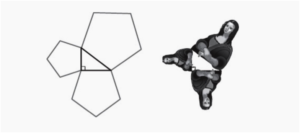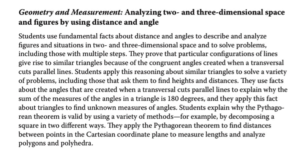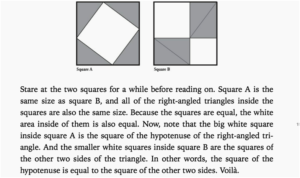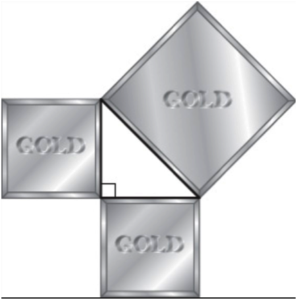All Things Pythagorean

Anna Thompson
Algebra, Geometry, and STEM teacher
Ely Memorial Middle and High School
MCTM Region 8 Director
The Pythagorean Theorem has never seemed the same to me since seeing it rendered in terms of the Mona Lisa. Alex Bellos in his book, Here’s Looking at Euclid*, takes us on a journey through the amazing world of mathematics. In Chapter Two, “Behold!,” he extends the application of the Pythagorean Theorem from areas of squares to areas of pentagons and to areas of three similar Monas surrounding a right triangle. I’m not suggesting using the Mona Lisa to introduce our theorem, however the bizarre can be useful in interesting those who see mathematics as a mundane “sport.”

Fig. 1
In the Minnesota Math Standards, we first meet the Pythagorean Theorem in 8th Grade as Standards 8.3.1.1 (ranked by the Benchmark Toolkit as a “more difficult” standard) and 8.3.1.2 (ranked as an “average” difficulty standard). It has been my experience that 8th grade students have seen or used the theorem in earlier grades (more on prerequisites later), but it is formally introduced as a a Grade 8 Minnesota Math Standard.
Links to both standards in MN Frameworks:
http://www.scimathmn.org/stemtc/frameworks/831pythagorean-theorem
In the NCTM Curriculum Focal Points PreK-Grade 8 Mathematics (below), it is also introduced in Grade 8:

Proof by Decomposing a Square Fig. 2

(Figure 2 and note above from Here’s Looking at Euclid, A. Bellos, 2010.)
The above simple proof-without-words came from the Chinese and predates Pythagorus. This proof adds to a notion that Pythagorus may not have been the first to observe the pattern.
Dynamic Proof by Water of Pythagorean Theroem and Proof by Lego (my favorite)
http://thekidshouldseethis.com/post/the-pythagorean-theorem-water-demo
Beyond the Pythagorean Theorem
An extension of the Proof by Water might be to discuss the mathematics behind why it works even though this “proof” actually involves volume, not area. This could be addressed when working with solving equations. Or, for more advanced students…how the Law of Cosines relates to the Pythagorean Theorem at 90o. A further extension could be using the Pythagorean Theorem as a springboard to introducing Fermat’s Last Theorem.
Prerequisite Knowledge and Misconceptions
Students must be able to identify the hypotenuse of a right triangle in any orientation.
Students must be able to connect using right triangles as a way to determine distance in the coordinate plane and in the real world.
Students must realize Pythagorean Theorem only refers to right triangles.
Students often confuse the Pythagorean Theorem and its Converse with a + b = c.
My purpose in writing this article was to share some ideas and links that I used when trying to take the Pythagorean Theorem beyond a2 + b2= c2.
So, I wonder……is the Pythagorean Theorem worth its weight in gold?

Fig. 3
What would Euclid say?
*Postscript: For those of you who enjoyed the play on words in the title Here’s Looking at Euclid and for those of you who don’t know to what it refers, here’s a little two minute clip from “Casablanca (1942) just for fun.
“Here’s looking at you kid.” : https://m.youtube.com/watch?v=dqhNZJKMFLc
Fig. 1-3 Here’s Looking at Euclid,A. Bellos, 2010
